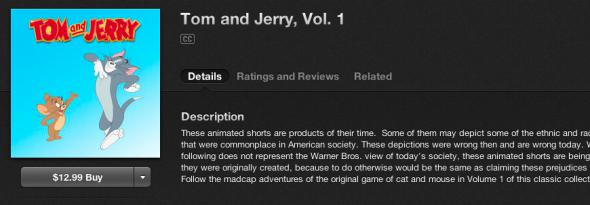Is that cartoon cat racist? Amazon Prime and iTunes now feature a warning for Tom and Jerry cartoons from the 1940s and 1950s, which notes that they “may depict ethnic and racial prejudices that were once commonplace in American society.”

Slate
The warning, let’s call it the Disclaimer, continues, “Such depictions were wrong then and are wrong today.”
Cue large amounts of Internet outrage from those decrying political correctness.
In fact, the language appears adapted from an introduction to the 2005 DVD box of Tom and Jerry: The Spotlight Collection, Volume 2. In it, Whoopi Goldberg discusses the supporting character of Mammy Two-Shoes, a stereotypical black housemaid who never became more than an aproned, drawling, doddering fodder for cheap laughs.
It is unclear whether Amazon or iTunes made an editorial decision to flag these particular cartoons for their content, or simply auto-published the warning in the same way they might list a movie with its MPAA rating. But these days, it seems the first two things jettisoned in any conversation about race are history and proportionality.
So first, history. William Hanna and Joseph Barbera’s 1940 creation for MGM was a quintessentially American tale. The antagonist, Tom, was big and scary, but slow and possessed of more will than wit. The underdog—in this case, a mouse named Jerry, sly, jestering, and adorable—always won. It was also thoroughly American in its nod to racism.
After George Herriman’s “Krazy Kat” set the standard for mid-century cartoon storytelling, no human being could ever be smarter than animals. In Tom and Jerry, as with Mickey and Bugs and the rest, that human would have to be of color. Enter Mammy Two-Shoes, whose face was almost never depicted. Henry Sampson’s comprehensive study, That’s Enough Folks! Black Images in Animated Cartoons, 1900-1960, summarizes 15 cartoons between 1940 and 1952 featuring Mammy, including scenes in which she sings about pork chops while washing dishes, has a pair of dice fall out of her dress when Jerry shakes her down, and is buried by an avalanche of coal, which gives occasion for Tom to continue his antics in Stepin Fetchit blackface.
As ethnic studies professor Christopher P. Lehman makes clear in The Colored Cartoon: Black Representation In American Animated Short Films, 1907-1954, Mammy Two-Shoes was also played for racially sexualized jokes. He cites a scene in 1942’s “Fraidy Cat” in which, as the script reads, “The cat comes in on her fanny with all four paws and draws up for a big bite … Off-scene, the maid is heard screaming, ‘Yipe!’ Then she yells sore, ‘Thomas, you no good cat, attacking from the rear, heh?’”
One of Tom and Jerry’s animators, Jack Zander, told Lehman, “Now the mammy in Tom and Jerry was an outright racist cartoon character. [She] had the typical negro voice and served as a foil for the two animal characters. Showing just her feet and lower body kept us from worrying about her face and making her another ‘character’ to give personality to.”
Mammy was voiced by Lillian Randolph, one of only a few black actors employed in the cartoon studio system during “the golden age of animation.” But in 1949—when being politically correct meant supporting segregation—the NAACP began protesting the studio over Mammy Two-Shoes. By the 1980s protests by groups representing communities of color against the lack of representation and a tide of misrepresentation became routine. Soon, talk in entertainment company boardrooms shifted from defusing demonstrations to discussions of how to address the nation’s changing demographics. They wanted to pivot toward “emerging” and “underserved” populations without losing their core white suburban audiences.
The same company that released Song of The South in 1946 would be making The Lion King, Pocahantas, and Mulan almost a half century later. Now eyeing a big world in which most consumers would be young and non-white, Disney and other companies developed multicultural ambitions.
Little wonder that Warner, which through waves of consolidation came to control the MGM archives, became worried about how some of its legacy properties might be viewed. Hundreds of cartoons from the golden age were removed from public access. (See Ken Padgett’s website banned-cartoons.com for a quick primer.) The Disclaimer is hardly an anvil drop. It’s an extension of global-facing corporate policy.
Which brings us to proportionality. There is a good debate to be had about whether and how racist cartoons should be shown. In this instance, Goldberg’s school-teacherly context-setting DVD commentary seems like a useful way to do so. But instead the opponents of the Disclaimer have claimed it is a form of censorship.
It is not. Golden age fans can point to Warner’s infamous “Censored 11” for that. The censorship argument itself is a carryover from the 1980s, when neocons opposed student calls for campus policies encouraging racial tolerance and intercultural awareness. It was during that fight that the right crystallized its attack against “political correctness.” By now it has hardened into a knee-jerk talking point, a sure-shot conversation killer.
What argument is left for the comment boards? That the Disclaimer is the nasty work of humorless coastal liberals bent on eliminating everyone’s right to have fun. But of course no one is saying you can’t watch the cartoons, much less enjoy them—especially in a complicated kind of a way, as Goldberg does.
So what does an argument in the waning of the Obama years over a gentle warning attached to a bunch of old, sometimes racist cartoons about a cat, a mouse, and a maid tell us? The Disclaimer may be an indication that times have indeed changed. But the strange fury of this debate may also begin to tell us how and why they haven’t.